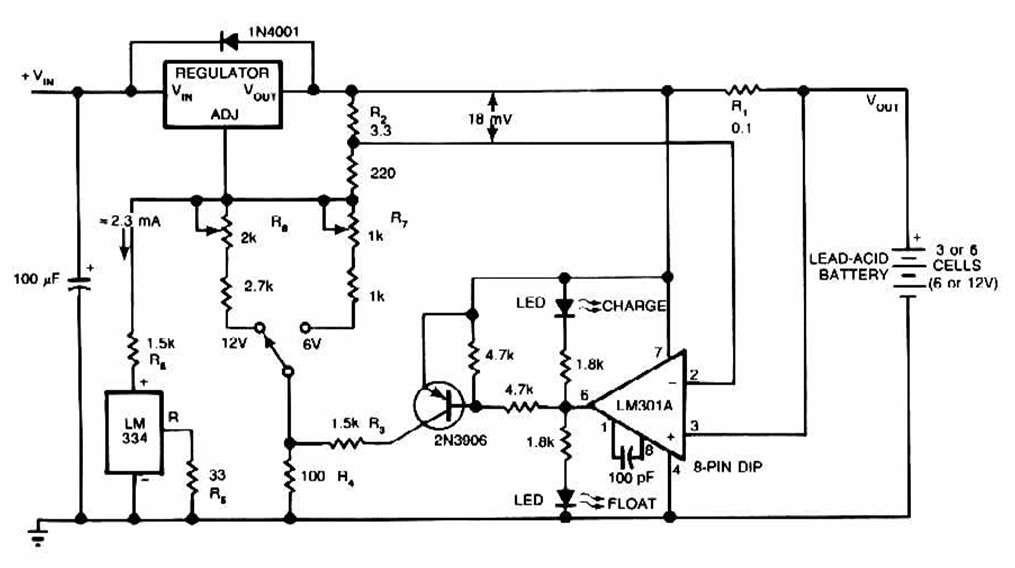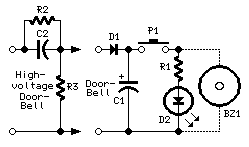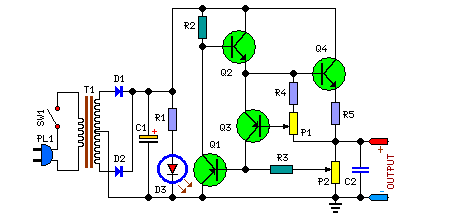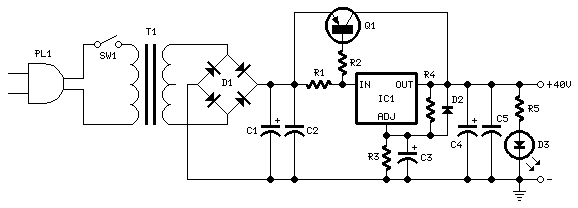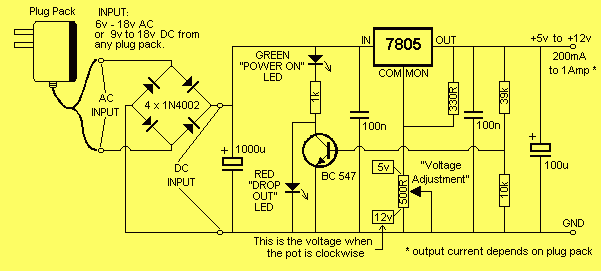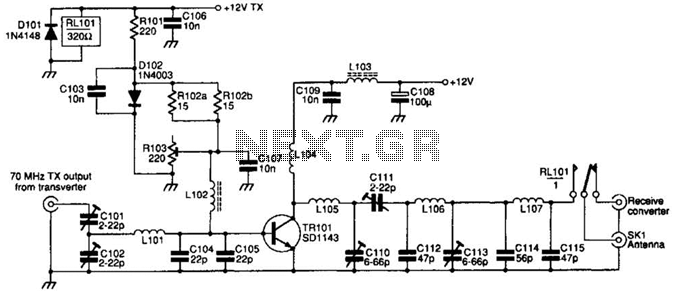
Power Supply Schematic
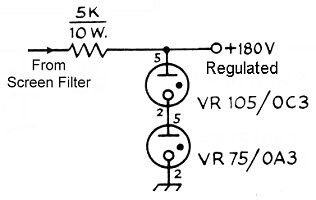
The power transformer features three secondary windings: 720V at 120mA center-tapped for the plate and screen supplies, 6.3V at 3.5A for the tube filament and bias power supply, and 5V at 3A (unused). Since the 5V secondary is not utilized, a slightly higher current than 120mA can be safely drawn from the high voltage secondary. This high voltage secondary connects to a conventional full-wave bridge rectifier, converting AC to unfiltered DC, which is then directed to the plate power supply filter. Due to the insufficient PIV (Peak Inverse Voltage) rating of a single diode, two diodes are arranged in series, resulting in four diodes (D1 through D4) comprised of two 1N4007 diodes in series. For the plate supply, the transformer center tap is not utilized, while it is employed for the screen supply. The output from the plate rectifier is direct current (DC) but contains a significant alternating current (AC) component. This output is then fed into a choke input filter, which allows the DC component to pass while presenting high impedance to the AC component. The filter capacitors act as an open circuit to the DC but effectively short-circuit the AC component to ground, minimizing AC presence at the output. With a maximum rating of 450V, two capacitors are connected in series to create a 900V 50µF capacitor. Two 40k, 10W bleeder resistors are placed in parallel with each capacitor, serving multiple functions: (a) they discharge the filter capacitors when the unit is powered off, preventing potential electric shock; (b) they provide a minimum load on the power supply to avoid excessive output voltage during standby; and (c) they equalize voltage across the filter capacitors. The power supply in the 6146B transmitter is referred to as an "Economy Supply," utilizing the transformer and rectifiers efficiently. All four diodes form a full-wave bridge rectifier for the plate supply, while only diodes D1 and D2 are used for the screen supply, creating a conventional full-wave center-tapped rectifier with an output half that of the plate supply. This output feeds the screen filter, which operates similarly to the plate supply filter. The screen filter output is directed to a voltage regulator that maintains a constant 180V, unless the current exceeds the maximum rating for the 6146B, at which point the voltage begins to drop. Regulated screen voltage is crucial in a linear amplifier, as variations can lead to non-linear tube operation and signal distortion. Gaseous regulator tubes like the 0C3 and OA3 maintain a constant voltage across them as long as the current remains between approximately 4mA and 30mA. When connected in series, these tubes function as a single tube with a voltage equal to their combined values. The dropping resistor (5k in this instance) is critical, as it must be chosen to ensure the regulator tubes remain operational when screen current is 15mA or less, and extinguish if the current exceeds about 17mA (the maximum permissible for the 6146B at 180V screen voltage). An excessively low resistor value risks damaging the tube by overheating the screen during amplifier tuning. When the appropriate resistor value is selected, the screen voltage remains stable during normal operation but decreases if excessive current is drawn.
The power transformer design incorporates multiple secondary windings to provide various voltage levels necessary for different operational components of the system. The 720V center-tapped secondary is crucial for both the plate and screen supplies, while the 6.3V secondary serves the tube filament and bias power supply. The unused 5V secondary allows for an increased current draw from the high voltage secondary without risking overloading the transformer.
The full-wave bridge rectifier configuration, composed of two pairs of series-connected 1N4007 diodes, is essential for converting the AC voltage from the transformer into usable DC voltage. This configuration ensures that the rectifier can handle the voltage and current requirements of the plate supply effectively. The choke input filter is a critical component, filtering out the AC ripple from the rectified DC, allowing for a smoother and more stable output voltage, which is vital for the reliable operation of the amplifier.
The inclusion of bleeder resistors is a safety feature, ensuring that the filter capacitors discharge when the unit is powered down, thereby reducing the risk of electric shock. Additionally, these resistors provide a load to stabilize the output voltage during idle periods, preventing excessive voltage buildup that could potentially damage components.
The voltage regulation for the screen supply is particularly important in maintaining linear operation of the amplifier. The use of gaseous regulator tubes provides a stable voltage as long as the current remains within specified limits, ensuring consistent performance and minimizing distortion. The design takes into account the thermal characteristics of the components, ensuring that the dropping resistor is appropriately sized to prevent overheating during operation.
Overall, the design of the power supply in the 6146B transmitter exemplifies a careful balance of component selection and configuration to achieve reliable performance, safety, and operational efficiency.The power transformer has three secondaries: 720V at 120mA center-tapped for the plate and screen supplies, 6. 3V at 3. 5A for the tube filament and bias power supply, and 5V at 3A (not used). Since the 5V secondary is not used, a little more current than 120mA can safely be drawn from the high voltage secondary.
The high voltage secondary feeds a c onventional full wave bridge rectifier to convert the AC to unfiltered DC, which is then fed to the plate power supply filter. Since the the PIV rating of one diode is not enough, two must be used in series, so the four diodes D1 through D4 are actually two 1N4007 diodes in series.
For the purposes of the plate supply, the transformer center tap is not used. However, the center tap is used for the screen supply. The output from the plate rectifier is direct current (DC) but with a large alternating current (AC) component superimposed. The output from the rectifier in fed to a choke input filter. The filter choke allows the DC component to flow through, while offering a very high impedance to the AC component.
The filter capacitors are essentially an open circuit to the DC, but they effectively short circuit the AC component to ground. The result is that little of the AC component reaches the output. Since the capacitors have a maximum rating of 450V, two are used in series to form a 900V 50uf capacitor.
Two 40k, 10W bleeder resistors in parallel with each of the capacitors serve several important functions: (a) They bleed off the charge on the filter capacitors when the unit is shut off, preventing the possibility of a dangerous electric shock that could occur even though the unit were turned off and unplugged. (b) They provide a minimum load on the power supply to prevent the output voltage from soaring during standby periods.
(c) They equalizes the voltage across the filter capacitors. The power supply in the 6146B transmitter is a design commonly called an "Economy Supply". This design makes use of the power transformer and rectifiers in a very clever manner. All four diodes are used to form a full wave bridge rectifier for the plate supply, but for the screen supply, only diodes D1 and D2 are used. These two diodes, along with the transformer center tap, form a conventional full wave center tapped rectifier.
The output of this rectifier is half that of the plate supply. This then feeds the screen filter. The output from the screen rectifier is then fed to the screen filter, which is a choke input filter which functions exactly the same as the plate supply filter. The screen filter then feeds the screen regulator. The output of the screen filter is fed to a voltage regulator that keeps the voltage at a constant 180V, unless the current exceeds the maximum value for the 6146B.
The voltage then starts to fall off. Regulated screen voltage is very important in a linear amplifier, since the tube operation is sensitive to variations in screen voltage. If the screen voltage varies with the signal, the tube will not operate linearly, and distortion of the signal results.
Gaseous regulator tubes such as the 0C3 and OA3 have the property that as long as the current through them is between about 4mA and 30mA the voltage across the tube is constant. When such tubes are placed in series they act as a single tube that operates at the sum of their voltages.
The value of the dropping resistor (5k in this case) is quite critical. The resistor must be selected so that the regulator tubes remain lit if the screen current is 15mA or less, but extinquish if the current goes over about 17mA (the maximum permissible value for the 6146B at a screen voltage of 180V). If the resistor value is too low, it is possible to damage the tube by overheating the screen, as can easily happen during amplifier tune-up.
When the proper value is selected, the screen voltage stays constant during normal operation, but drops if too much current is drawn, li 🔗 External reference
The power transformer design incorporates multiple secondary windings to provide various voltage levels necessary for different operational components of the system. The 720V center-tapped secondary is crucial for both the plate and screen supplies, while the 6.3V secondary serves the tube filament and bias power supply. The unused 5V secondary allows for an increased current draw from the high voltage secondary without risking overloading the transformer.
The full-wave bridge rectifier configuration, composed of two pairs of series-connected 1N4007 diodes, is essential for converting the AC voltage from the transformer into usable DC voltage. This configuration ensures that the rectifier can handle the voltage and current requirements of the plate supply effectively. The choke input filter is a critical component, filtering out the AC ripple from the rectified DC, allowing for a smoother and more stable output voltage, which is vital for the reliable operation of the amplifier.
The inclusion of bleeder resistors is a safety feature, ensuring that the filter capacitors discharge when the unit is powered down, thereby reducing the risk of electric shock. Additionally, these resistors provide a load to stabilize the output voltage during idle periods, preventing excessive voltage buildup that could potentially damage components.
The voltage regulation for the screen supply is particularly important in maintaining linear operation of the amplifier. The use of gaseous regulator tubes provides a stable voltage as long as the current remains within specified limits, ensuring consistent performance and minimizing distortion. The design takes into account the thermal characteristics of the components, ensuring that the dropping resistor is appropriately sized to prevent overheating during operation.
Overall, the design of the power supply in the 6146B transmitter exemplifies a careful balance of component selection and configuration to achieve reliable performance, safety, and operational efficiency.The power transformer has three secondaries: 720V at 120mA center-tapped for the plate and screen supplies, 6. 3V at 3. 5A for the tube filament and bias power supply, and 5V at 3A (not used). Since the 5V secondary is not used, a little more current than 120mA can safely be drawn from the high voltage secondary.
The high voltage secondary feeds a c onventional full wave bridge rectifier to convert the AC to unfiltered DC, which is then fed to the plate power supply filter. Since the the PIV rating of one diode is not enough, two must be used in series, so the four diodes D1 through D4 are actually two 1N4007 diodes in series.
For the purposes of the plate supply, the transformer center tap is not used. However, the center tap is used for the screen supply. The output from the plate rectifier is direct current (DC) but with a large alternating current (AC) component superimposed. The output from the rectifier in fed to a choke input filter. The filter choke allows the DC component to flow through, while offering a very high impedance to the AC component.
The filter capacitors are essentially an open circuit to the DC, but they effectively short circuit the AC component to ground. The result is that little of the AC component reaches the output. Since the capacitors have a maximum rating of 450V, two are used in series to form a 900V 50uf capacitor.
Two 40k, 10W bleeder resistors in parallel with each of the capacitors serve several important functions: (a) They bleed off the charge on the filter capacitors when the unit is shut off, preventing the possibility of a dangerous electric shock that could occur even though the unit were turned off and unplugged. (b) They provide a minimum load on the power supply to prevent the output voltage from soaring during standby periods.
(c) They equalizes the voltage across the filter capacitors. The power supply in the 6146B transmitter is a design commonly called an "Economy Supply". This design makes use of the power transformer and rectifiers in a very clever manner. All four diodes are used to form a full wave bridge rectifier for the plate supply, but for the screen supply, only diodes D1 and D2 are used. These two diodes, along with the transformer center tap, form a conventional full wave center tapped rectifier.
The output of this rectifier is half that of the plate supply. This then feeds the screen filter. The output from the screen rectifier is then fed to the screen filter, which is a choke input filter which functions exactly the same as the plate supply filter. The screen filter then feeds the screen regulator. The output of the screen filter is fed to a voltage regulator that keeps the voltage at a constant 180V, unless the current exceeds the maximum value for the 6146B.
The voltage then starts to fall off. Regulated screen voltage is very important in a linear amplifier, since the tube operation is sensitive to variations in screen voltage. If the screen voltage varies with the signal, the tube will not operate linearly, and distortion of the signal results.
Gaseous regulator tubes such as the 0C3 and OA3 have the property that as long as the current through them is between about 4mA and 30mA the voltage across the tube is constant. When such tubes are placed in series they act as a single tube that operates at the sum of their voltages.
The value of the dropping resistor (5k in this case) is quite critical. The resistor must be selected so that the regulator tubes remain lit if the screen current is 15mA or less, but extinquish if the current goes over about 17mA (the maximum permissible value for the 6146B at a screen voltage of 180V). If the resistor value is too low, it is possible to damage the tube by overheating the screen, as can easily happen during amplifier tune-up.
When the proper value is selected, the screen voltage stays constant during normal operation, but drops if too much current is drawn, li 🔗 External reference
